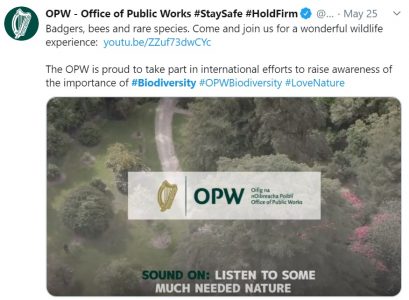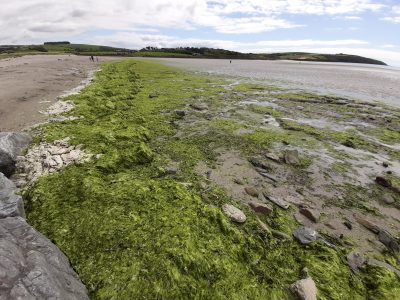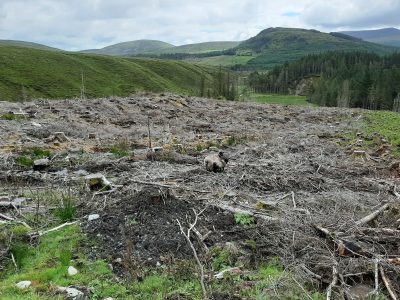
Beware all ye who enter
A couple of years back I attended a conference on ‘Natural Capital’ in the National Concert Hall in Dublin. Natural Capital is a way of bringing nature into national economic accounting structures in order to value what are termed ‘ecosystem services’ – i.e. the things that keep us alive like fresh water, clean air and healthy food. I’m not a fan of the idea but I can see the point that some ecologists make: that up to now nature has been invisible in our economic structures and that making it visible will result not only in less destruction of it but more investment in restoring it to health. My principle gripe with Natural Capital is that it is a way of squeezing nature into our economic mindset – whereas what is really needed is the exact opposite: the economy must find a way to fit within the natural system.
At the conference attendees heard about how some corporate entities were coming around to the idea, particularly where shareholders were increasingly concerned with the environmental impacts of the product or service they were selling. Natural Capital would go beyond ‘Corporate Social Responsibility’ (now generally discredited) as it would be measurable using hard and fast methodologies. Nevertheless, the great pitfall here is that while companies and their shareholders may well want to do right by ‘the environment’, the profit-motive which is embedded in the economic system will ultimately override that. Meanwhile, companies will want to maximise profits while using any ‘green’ initiatives to give their brand a competitive advantage. This is the slippery slope to ‘greenwashing’: dressing something up as eco-friendly when in fact it is nothing of the sort. I remember asking a question of one of the speakers as to how we could be sure that corporate claims were genuine. The reply I got was to look for where the messaging was coming from; if it was the marketing department that was making the claims, then it was most likely there’d be a whiff of greenwashing. At the time ‘Origin Green’ was in full flow, making claims that Irish agriculture was among the world’s most sustainable and which was devised and orchestrated by An Bord Bia – the marketing wing of the Irish food and drinks industry. ‘Origin Green’ claims were never real and, although it limps on (presumably to save face among those in Bord Bia and the Department of Agriculture, Food and the Marine who devised it) its credibility has long evaporated. In using up its supply of credibility chips, the ‘green’ card will be harder to sell in any future marketing programme – this is why greenwashing is so harmful in the longer-term.
It is not only Origin Green/An Bord Bia that has fallen victim to its own hype. Bord na Móna – responsible for the destruction of our midlands bogs and the knowing extinction of the Rannock Rush from Ireland – sold itself for a while as ‘Naturally Driven’ while the Office of Public Works – unrestrained destroyer of rivers – turns up to events like ‘Bloom’ in Dublin’s Phoenix Park with displays extolling the importance of protecting our biodiversity.
Last month I took a hike through the ‘Wild Nephin’ lands in west Mayo, a project which promised Ireland’s largest ‘wilderness’ area back in 2013 and where we were told that large industrial plantations of commercial conifers would be transformed into naturalised woodlands and restored bogs. Nothing of the sort happened, with commercial harvesting and replanting continuing up to at least 2018. Yes, the signs all went up and a large wooden display on approach welcomes the visitor to the ‘Wild Nephin Wilderness Area’. A feature in the Sunday Independent newspaper from only last month on Ireland’s best outdoor spaces described ‘Wild Nephin’ as a “wonderfully untamed wilderness”. Few people involved with selling Mayo as a tourist destination seem concerned at the lack of authenticity behind these articles which are, let’s face it, false advertising.
Our latest example comes from Killarney National Park where the oakwoods remain Ireland’s most expansive example of Atlantic rainforest – despite its long-standing and well documented issues. Since the 1980s Killarney was one of only two UNESCO Biosphere Reserves in Ireland (the other being Bull Island in Dublin which has since expanded to encompass all of Dublin Bay). In 2017 the IWT complained to UNESCO that lack of management was resulting in deterioration of the site and that the authorities (the National Parks and Wildlife Service, NPWS) had never produced a ‘periodic review, despite there being a requirement to produce one every three years. We felt at the time that the Biosphere designation should be removed to save its integrity. Instead, the first periodic review was hastily produced and UNESCO decided to re-award the status, but this time to include all of Lough Lene and an expanse of the Macgillycuddy Reeks Mountains as well as Killarney National Park. Minister for Heritage at the time, Heather Humphreys, welcomed the new designation, which would require the collaboration between the NPWS and Kerry County Council, as showing “how important the Department views the protection of our most important areas of natural heritage”.

Pollution, resulting in excessive growths of green algae, along the ‘Wild Atlantic Way’ in Co. Cork
Three years later the IWT discovers (arising from a Freedom of Information request) that no progress has been made in any of the commitments made to UNESCO to develop the Biosphere. It transpires that in 2018 Kerry County Council withdrew support – something which was decried by the NPWS as “very disappointing” and “very disingenuous of the council”. The Council now claim that they have not walked away and that the appointment of a Biosphere Officer is ‘imminent’. Nevertheless, the listing of the Kerry Biosphere remains on the UNESCO website. Has UNESCO been aware that no progress has been made? Or is it the case that, just like for 30 years Killarney National Park hadn’t come under any pressure to produce a periodic review, that the UNESCO Biosphere brand is just more greenwashing? We have written to UNESCO and hope to get answers, but if the Biosphere brand is to retain any credibility it must be removed from the Killarney site without delay.
Marketing works – but people are not stupid; eventually the fakery is busted and the very real, underlying problems have most likely worsened, meaning they are harder to address than they would have been had we taken genuine action sooner. I can’t help but wonder if the energy that goes into pretending that we have a healthy environment went into actually dealing with the issues, then we might have a story that was worth selling. But that would involve engaging with reality.

‘Wild Nephin’ – where the visitor is promised an experience of ‘untamed wilderness’.